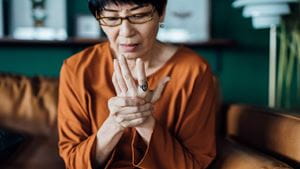
Maintaining healthy bones is an important part of everyday life. Our skeletons support and protect our body and keep us moving each day.
For women in particular, osteoporosis can be a dangerous health condition to live with – especially if it leads to a bone fracture. Fractures can lead to hospitalization, nursing home stays, and a loss of independence.
Kate Grant, DO, is a primary care sports medicine physician with Rochester Regional Health and gives insight into how osteoporosis develops, what can be done to treat it, and how to keep your bones healthy.
Osteoporosis is the thinning of bones in the body. For many people, this is a natural part of aging; the older we are, the less dense our bones will become.
However, there are certain risk factors that elevate the risk for women developing osteoporosis more quickly and severely. These include:
“Osteoporosis affects everyone’s health,” Dr. Grant said. “Hundreds of thousands of individuals are hospitalized every year due to osteoporosis and related hospitalizations or injuries.”
If a patient ends up with a fracture, approximately 20 percent of these patients go into a nursing home and only about 40 percent of patients are able to regain their independence.
Studies show patients who move from independent living to assisted living facilities or nursing homes have an increased risk of falling. If a person with osteoporosis suffers a fall, the result could be catastrophic to their health.
According to the National Osteoporosis Foundation, the total cost of caring for Medicare patients with osteoporotic fractures is expected to surpass $95 billion by 2040.
If someone has osteoporosis, they often show no symptoms and do not present symptoms until they suffer a fracture. Most patients who have been diagnosed with osteoporosis will work with their primary care provider to manage the condition.
If a patient’s osteoporosis progresses significantly, they are referred to an endocrinologist. As needed, they will receive a bone density or DEXA scan – using low dose X-rays to see how dense your bones are. Women over age 65 are usually screened, according to the recommendation from the American Academy of Family Practitioners. The screening will focus primarily on the hips and lumbar spine – the two areas of the body that are the most at risk.
There are a number of habits and lifestyle changes women can undertake to keep their bones healthy.
The most important thing women can do is to take supplements of calcium and vitamin D. Calcium alone is not sufficient; vitamin D helps your bones absorb the calcium.
Doctors say the recommended daily amount of each supplement for pre-menopausal women is 1,000 mg. of calcium and 600 IU of vitamin D. For women who are post-menopausal, the recommended daily amount is 1200 mg. of calcium and 800 IU of vitamin D.
Exercise can be very beneficial for bone health. Simple weight-bearing and aerobic exercise activities are protective against osteoporosis. These include:
Making healthy changes to your lifestyle can help to reduce the risk of developing osteoporosis. These changes can include:
“Even a simple fall for someone with osteoporosis has the potential to lead to an injury,” Dr. Grant said. “When you get over the age of 65, falls are the leading cause of fatal and non-fatal injuries. This is what sends people to the hospital most often when they are older. A hip fracture will likely result in individuals being placed in an assisted living facility or nursing home, which is where an increased risk of falling occurs.”